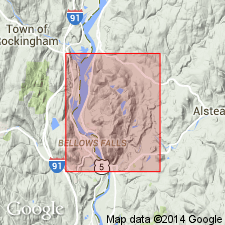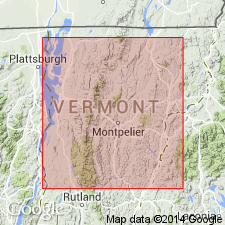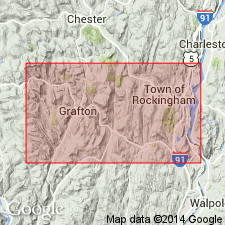
- Usage in publication:
-
- Bellows Falls granite
- Modifications:
-
- Original reference
- Dominant lithology:
-
- Granite
- AAPG geologic province:
-
- New England province
Summary:
Pg. 11-12 and map dated 1822. In description of Connecticut River area from New Haven, Connecticut, to Bellows Falls, Vermont, introduced Bellows Falls granite for a "sienitic granite."
Source: US geologic names lexicon (USGS Bull. 896, p. 154-155).

- Usage in publication:
-
- Bellows Falls granite gneiss
- Modifications:
-
- Age modified
- AAPG geologic province:
-
- New England province
Summary:
Table opp. p. 288. Assigned Bellow Falls granite gneiss to Cambrian, but without description or discussion.
Source: US geologic names lexicon (USGS Bull. 896, p. 154-155).

- Usage in publication:
-
- Bellows Falls gneiss
- Modifications:
-
- Age modified
- Areal extent
- AAPG geologic province:
-
- New England province
Summary:
Pg. 229. Bellows Falls gneiss. Underlies village of Bellows Falls, Vermont, extends south into Westminster, and east across Connecticut River into Walpole, New Hampshire. Is also found in extreme southeast corner of Charlestown, New Hampshire. Varies from medium to coarse, and in places becomes porphyritic. Color varies from light or medium gray to very dark gray. Is an acid intrusive. Age is definitely post-Ordovician, for the gneiss cuts Brattleboro phylllte, which is Ordovician.
Source: US geologic names lexicon (USGS Bull. 896, p. 154-155).
For more information, please contact Nancy Stamm, Geologic Names Committee Secretary.
Asterisk (*) indicates published by U.S. Geological Survey authors.
"No current usage" (†) implies that a name has been abandoned or has fallen into disuse. Former usage and, if known, replacement name given in parentheses ( ).
Slash (/) indicates name conflicts with nomenclatural guidelines (CSN, 1933; ACSN, 1961, 1970; NACSN, 1983, 2005, 2021). May be explained within brackets ([ ]).

